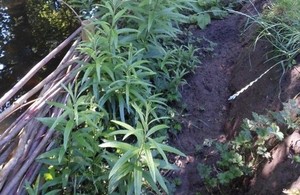Safe haven created for native species on Leeds stream
Natural techniques have been used to create crayfish habitat.

Willow spiling protects banks from erosion.
A safe haven for a protected native species has been created using natural engineering techniques.
The Environment Agency and Yorkshire Wildlife Trust have worked in partnership to stabilise the banks of a stream in Leeds and build refuges for the native white-clawed crayfish, using willow spiling.
The area has an established population of native white-clawed crayfish, but was identified as in need of possible habitat improvement because there were many eroded banks with very little vegetation or suitable areas for the crayfish to burrow into.
Eroding riverbanks can cause problems for crayfish habitats because the eroded sediment can cause siltation and pollution of the stream blocking potential refuges for the crayfish and altering the quality of the water. A bank that is eroding is also unstable and unsuitable habitat for crayfish as it will not give adequate protection against fast flowing water.
Up to 100 metres of willow spiling and bundling has been built along the stream. The technique used for the willow spiling involves weaving willow between stakes on the bank to form a strong willow wall. Live willow was used so that it will root and grow creating a strong hedge that protects the bank from further erosion and provide habitat for crayfish.
Ian Marshall, biodiversity officer at the Environment Agency said:
The stream has suffered from excessive siltation which has impacted on fish and rare invertebrate communities living in it. However, by working closely with our partners to tackle erosion in a sustainable way, we have given the area the opportunity to improve for wildlife whilst remaining a popular destination for the public.
This work also helps us achieve our targets under the Water Framework Directive and pave the way for future partnership working across Yorkshire.
Elspeth Robinson, project assistant at the Yorkshire Wildlife Trust said:
I worked with several groups of fantastic volunteers over the course of two weeks to install the willow habitat along the beck. The willow has now started to sprout and is establishing along the banks, providing stability against erosion and brilliant habitat for the crayfish.
We have much more willow spiling and bundling planned for other streams around Leeds to help secure our populations of native white-clawed crayfish.
White clawed crayfish have been significantly threatened in this country by the invasion of the non-native American signal crayfish, and crayfish plague.
Native white-clawed crayfish have no natural defence against the plague. Once the fungal disease has become established, an entire population can be wiped out in just a week. The Environment Agency and its partners are working to establish safe havens on other streams to help protect the species.
White-clawed crayfish are Britain’s only native freshwater crayfish. They are protected under Schedule 5 of the Wildlife & Countryside Act 1981. It is an offence to intentionally take white-clawed crayfish from the wild.